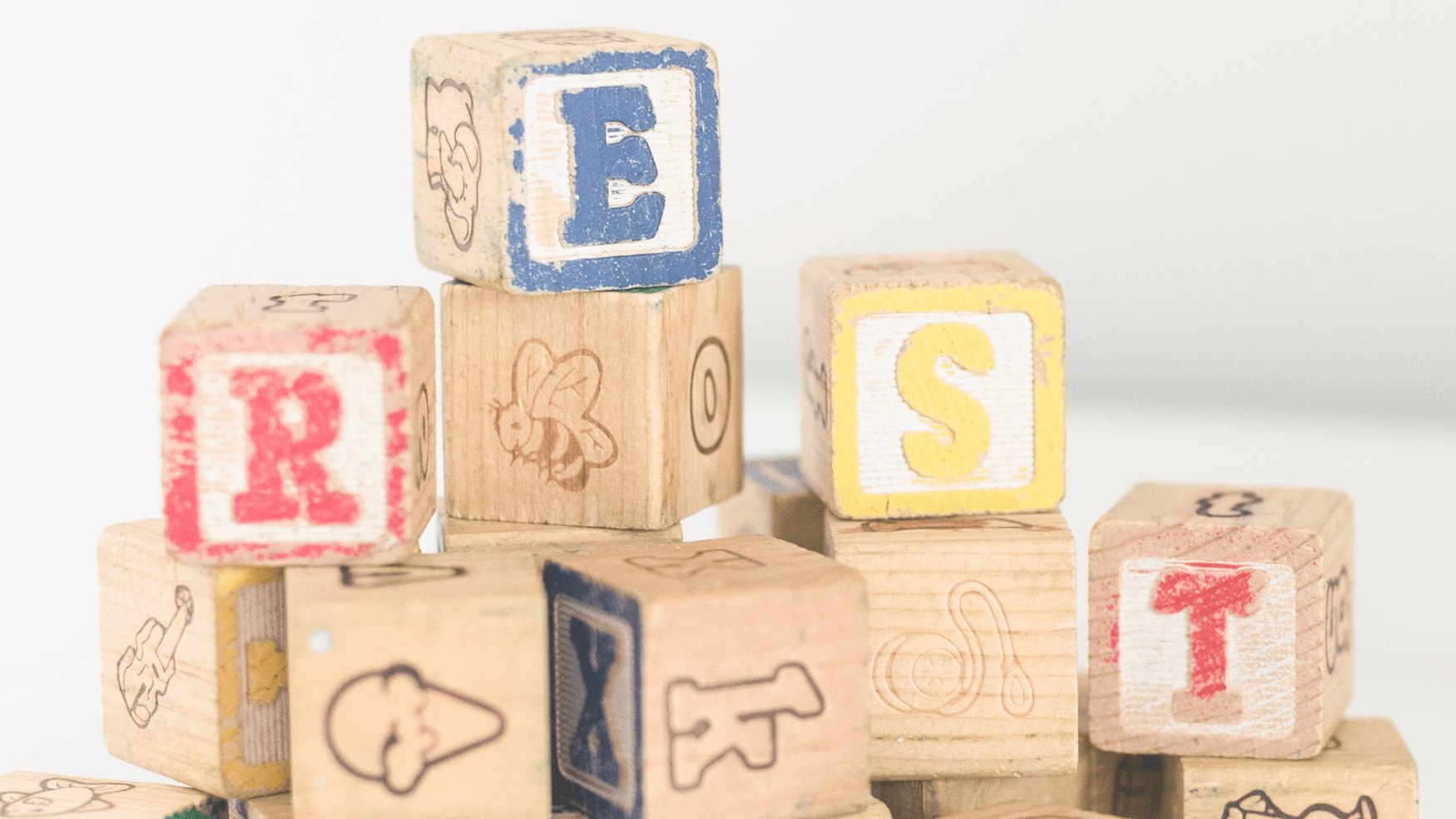A regression between 18 months and 2 years old is common. This regression is usually due to a combination of decreasing sleep needs, newfound independence, and separation anxiety. This might look like your toddler fighting bedtime, new night wakings, or chronic early mornings. Read the tips below to figure out why this is happening and what you can do about it.
WHAT CAUSES THE 18-MONTH/2-YEAR REGRESSION?
Decreasing Sleep Needs:
Sometimes the 18-month or 2-year regression is because parents are expecting too much sleep from their toddler, or daytime sleep is beginning to interfere with nighttime sleep. 18-month-olds need about 12.5-13 hours of total sleep in 24 hours, while most 2-year-olds need about 12-12.5 hours of total sleep in 24 hours. Sleep needs do vary, so some toddlers will need more while others need less. The majority of toddlers 18 months to 2 years old still need a daily nap in the afternoon. This nap helps them adequately meet their sleep needs and gets them through the day without becoming an overtired mess before bedtime.
Think about your child’s sleep as a pie. Too much daytime sleep will take away from nighttime sleep, and vice-versa. In general, we want to prioritize nighttime sleep over daytime sleep. If your 2-year-old is taking a nice 2-3 hour nap, that only leaves about 9.5 – 10 hours overnight before their sleep needs are filled. If they are going to bed at 7 pm, this may result in them being up at 5 am simply because they aren’t tired anymore. A 10-hour night is completely normal for some toddlers, however, it can be helpful to adjust expectations or move bedtime closer to 8 pm so you can achieve a later wakeup.
Increasing Independence:
It’s a fine line between meeting your child’s emotional needs and letting them run things at bedtime. 18-month-olds and 2-year-olds are finding their voice and testing boundaries. This is an expected part of their development, and of course, it’s frustrating for parents. The bedtime routine can often go off the rails around this age because of excessive requests or stalling at every opportunity. Your once solid bedtime routine may now feel endless because the structure of the bedtime routine is lost. They may have come to learn that if they ask for more books or one more backrub, this will extend time with mommy or daddy! Then, sometimes we see these requests spill over into overnight wakings as well. This leads to the next potential cause of this regression…
Separation Anxiety:
Separation anxiety is a natural part of toddler development and actually indicates a secure attachment with your child. As their desire for independence increases around 18 months, they still crave the reassurance and security of having their parent nearby. The level of disruption or protest caused by separation anxiety will depend on your child’s temperament and personality. Crying or tantrums related to separation anxiety often peaks before times of separation, like before daycare dropoff, at naptime, or before bed. This can sometimes lead to new challenges with naptime, bedtime, or even night wakings around 18 months to 2 years old.
HOW TO GET THROUGH THE 18-MONTH/2-YEAR SLEEP REGRESSION
Now that we’ve reviewed the potential contributing factors for this regression, let’s talk about how to fix it!
Adjust their schedule:
For 18-month-olds, a good time for the nap to start is 12:30 pm. For 2-year-olds, this may move to 1 pm, right after lunch. If you’re experiencing 5 am wakeups or other sleep challenges, avoid starting the nap before 12:00 pm for 18-month-olds and 12:30 pm for 2-year-olds. This is for two reasons: first, starting their nap too early in the day can reinforce early morning wake-ups. Second, we want to make sure that your toddler has enough sleep pressure to easily fall asleep for their nap and have the nap last about 1.5-2 hours for 18-month-olds and 1-1.5 hours for 2-year-olds.
Sample 18-Month Schedule:
6:30 am: Morning Wake Up
12:30-2:30 pm: Nap
8:00 pm: Bedtime
Sample 2-Year Schedule:
6:30 am: Morning Wake Up
1:00-2:30 pm: Nap
8:00 pm: Bedtime
Remember your child’s sleep pie? A nap that is too long can interfere with overnight sleep. You may need to cap your toddler’s nap to allow for enough sleep pressure for bedtime and overnight. A nap that’s too long (above 2 hours for 18-month-olds and 1.5 hours for 2-year-olds) can contribute to difficulty falling asleep at bedtime, overnight wakings, or 5 am wakeups.
Hold Boundaries with Bedtime and Overnight:
Rein in your child’s bedtime routine and be consistent with the steps. Here is a sample toddler bedtime routine:
- Hygiene: Brush Teeth, Bath, Potty or a clean diaper, PJs, comb hair
- Books: I recommend a max of 2 or 3 short books. Whichever amount of books you choose, stick with that number!
- Snuggle Time: Keep this short and sweet! If your child is struggling with you leaving after snuggle time, set a timer. Setting a timer (especially a visual timer!) will help your toddler understand the boundary. Incorporate family rituals during this time, like singing or prayers.
- Goodnight phrase: Avoid sneaking out! This can make separation anxiety worse. Instead, say a consistent goodnight phrase before leaving their room. If your toddler is aware that you are saying goodnight, they will eventually feel more confident in their ability to fall asleep on their own.
One simple but effective intervention for this sleep regression: offering age-appropriate choices during bedtime. Examples include: “which color pajamas would you like to wear, red or green?” or “which book would you like to read?” When offering choices, allow them to decide between two specific things, rather than leaving it completely open for them to decide, as this can be overwhelming and potentially lead to more battles. Choices help toddlers feel more in control and independent, which will help them be more agreeable during their routine. You can also give them ownership of other bedtime-related tasks, like turning on their sound machine or turning off the light. Avoid negotiating extra books or engaging with other stall tactics during bedtime. Consistently follow the steps of your routine, keeping it to about 30-40 minutes.
If your child protests at bedtime, or is having night wakings, respond in a way that offers kind reassurance while also holding on to the boundaries you’ve established surrounding their sleep. This might look like going into their room and offering a few minutes of support followed by 5-10 minutes of space. As parents, staying consistent can be very hard, but it’s actually what toddlers crave. It is confusing for them to sometimes get to sleep with mom and dad but sometimes they are expected to sleep in their crib. Decide as a family what you want your sleep routines to look like and stick to them.
Going “back to basics” with your sleep boundaries may make for a rough few days, but if you stay consistent, your child will quickly learn what to expect and begin to follow the boundaries you’ve established.
Fill Your Child’s Cup
An effective way to address separation anxiety in toddlers is role-playing. Do this during playtimes. Pretend to lie down, say goodnight, and go sleep – then it’s their turn! You can also practice stepping into the other room for a few moments and then returning, saying “mommy/daddy always comes back!”.
Another great way to help with separation anxiety is a social story. A social story is a communication tool to help children with transitions. It’s a story that you create all about your child told in the first person, ideally with pictures of them incorporated. You can customize their story to address whatever seems to be the most stressful for them. For example, you could create a story about daycare drop-off, how much fun school is, and how mommy and daddy will always come to pick you up at the end of the day. Or, you can create a sleep social story. Outline their bedtime routine, include pictures of their sleep space, and reinforce any sleep rules or boundaries within the story.
If your child is expressing fear of the dark (which typically does not happen until age 2 or later), you may choose to introduce a nightlight around this time. I recommend using an orange or red color because it is the least disruptive to sleep. Blue and bright white light can actually inhibit melatonin production. If the night light allows for it, set the brightness to the dimmest possible setting. A color-changing clock like the Hatch is a great option because it’s completely customizable, and you can program it as a cue for the morning.
SHOULD I JUST MOVE THEM TO A BED DURING THIS REGRESSION? WILL THAT HELP?
Short answer – no! Moving your toddler from the crib to a bed during the 18-month or 2-year regression will most likely make things worse, not better. Children at this age typically lack the necessary impulse control to stay in their bed all night long. It’s also just unsafe to have a toddler roaming around your house while you’re asleep.
If your child is not climbing out of the crib, I recommend keeping them in a crib until around 3 years old, and only making the transition when sleep is already going well.
If your child is climbing out of the crib, the safest thing to do is to transition to a bed. This can be a toddler bed or simply a mattress on the floor. Once you transition your toddler to a bed, think of their room as an expanded crib. Secure cords, anchor furniture, and remove anything too stimulating or anything unsafe. Their room should be just for sleep!
WHAT IF MY TODDLER REFUSES THEIR NAP DURING THIS REGRESSION?
This happens! An 18-month-old toddler is probably going to be pretty overtired by the end of the day if they don’t nap. Try to go for a car ride in the late afternoon to give them at least a 30-minute nap. Make sure this doesn’t happen too late – wake them by 3:30 pm.
On the other hand, 2-year-olds usually do okay skipping their nap from time to time. They will likely be a little cranky in the evening, so move bedtime about 45 minutes earlier to compensate.
HOW LONG WILL THIS REGRESSION LAST?
If you follow these tips, stay consistent, and make some schedule adjustments, your toddler should move through this regression in about one to three weeks.









